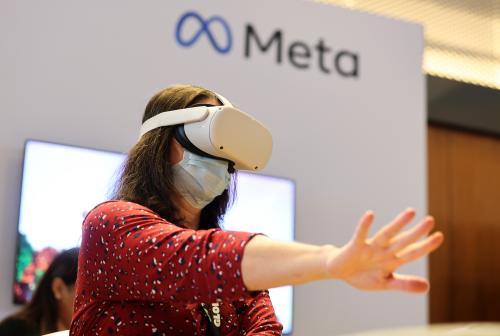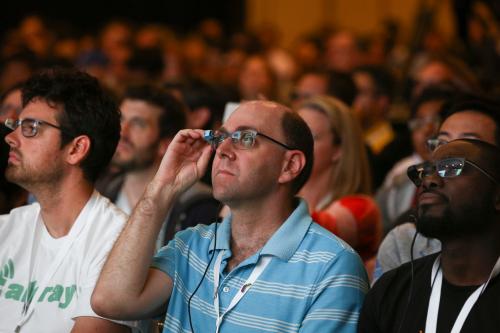Augmented reality and virtual reality (AR/VR) technologies are creating new means for education by opening doors for students to learn and teachers to instruct in a more immersive, technological environment. For example, medical school students can engage in experimental surgeries in virtual reality environments and biology pupils are able to engage with plants, mammals, birds, insects, and amphibians via technological simulations. But not all universities have equal access to leverage these and other emerging technologies. This means that some students face disadvantages in their preparation and on the job market because of a lack of economic and network resources to engage with new technologies.
As part of new Brookings research, scholars Dr. Rashawn Ray and Dr. Nicol Turner Lee are exploring the diversity, equity, and inclusion of these technologies with particular attention on how educational leaders from Minority-Serving Institutions (MSIs), which include Historically Black Colleges and Universities (HBCUs), Hispanic-Serving Institutions (HSIs), Tribal Colleges and Universities (TCUs) and community colleges with disproportionate numbers of Black, Indigenous People of Color (BIPOC) students, are using and leveraging AR/VR technologies for course instruction and other college-oriented guidance. The focus of the research is also related to the opportunities and barriers to the design and implementation of AR/VR scenarios that reflect culturally efficacious use cases and scenarios to increase BIPOC engagement, especially as professional opportunities become more lucrative in these professions.
The findings for this blog and future articles are based on virtual convenings, with the first one comprised of leaders from HBCU, HSI, and community colleges in July 2022. We draw on these conversations to inform our thinking about the opportunities and challenges of AR/VR.
AR/VR adoption
AR refers to the overlaying of digital information on a real-world backdrop, taking for example the technology used in the mobile game, Pokémon Go. VR, on the other hand, is fully immersive, accessed through a headset that creates a computer-generated world that users can manipulate. MR (mixed reality), meanwhile, combines the real world with the digital, allowing users to interact with both real world and virtual items without removing their headsets.
Nearly 30% of the U.S. population already uses AR every month. A Citi report predicts the market for the Metaverse could be between $8 trillion and $13 trillion by 2030. Unfortunately, little research has been compiled regarding equitable participation and adoption of AR/VR.
The number of diverse students on the production side of emerging technologies also continues to wane. The percentage of Black Americans earning doctoral degrees has stayed basically the same since the year 2000 at less than 6%. Within certain STEM disciplines, it is not uncommon to have years when no Black student earns a Ph.D. These statistics also impact the workforce as Black Americans represent less than 5% of employees at most major tech companies that are rivaling their innovations within the AR/VR industries.
Further, MSIs and community colleges are systematically underfunded, which has set back their adoption of AR/VR infrastructure due to its high up-front costs, especially with the purchase of headsets and other hardware. Fortunately, through partnerships and collaboration, opportunities for these institutions have increased and included AR/VR programs for educators and students at their institutions. Various institutions have also incorporated AR/VR into their education curriculum for a range of classes from STEM to the humanities, to create a more immersive learning environment for more vulnerable college students. In the Brookings roundtable, many of these programs were shared among participants and documented in the next section.
AR/VR in higher education
To understand how AR/VR is being used by administrators and professors at HBCUs, HSIs, and community colleges, Brookings invited a number of scholars and higher education administrators to a virtual convening in July 2022 to discuss diversity, equity, and inclusion. Institutions represented included: Morehouse University, Northern Virginia Community College, Bowie State University, and the Minority Broadband Initiative led by the National Telecommunications and Information Administration (NTIA) in the U.S. Department of Commerce.
Dr. Rashawn Ray, one of the lead scholars, kicked off the meeting with a demonstration from his Lab for Applied Social Science Research (LASSR), where they are using AR/VR programs related to equitable policing. Since 2017, LASSR has created over 100 VR modules, training over 2,000 police officers. LASSR receives funding from private corporations to develop these VR scenarios and police departments can buy software, equipment, and training from LASSR.
Other examples among the group on AR/VR use in higher education consisted of:
- Bowie State University, an HBCU, where immersive collaborative virtual environments (CVE) are simulating active shooter events at the university’s science building. The programs are supported by two grants from the National Science Foundation (NSF) for Minority-Serving Institutions and are helping professors collect data on how emergencies unfold. The active shooter response training is just one of the on-going projects at Bowie State University’s Virtual Reality Lab, which also uses VR environments to simulate COVID-19 testing sites, fire or bomb threat emergencies in a large city, and evacuation methods using Microsoft HoloLens. The Virtual Reality Lab allows students in the computer science department to get tangible experience designing, building, and testing VR spaces.
- Morehouse College, an HBCU, created four VR programs to transform classes into a virtual format during the pandemic called Morehouse in the Metaverse. As part of the program, four professors taught three courses in VR on a digital twin campus created in partnership with VictoryXR, with funding from Southern Company and Qualcomm. As of Fall 2022, Morehouse College has ten courses taught by nine professors in VR, in addition to 500 MetaQuest 2 in use by students, faculty, staff, and community members. Beyond the classroom, Morehouse is using an NSF e-fellows grant to prep computer science students for technical interviews using simulated experiences.
- Northern Virginia Community College (NOVA) has also implemented AR/VR in its education curriculum: their first project for health sciences students involved a simulation targeting delivering radiation in a VR environment. They also used some of their Higher Education Emergency Relief Fund (HEERF) to use VR simulations at the start of the pandemic to help students continue their studies during remote learning. Without continued federal funding, NOVA has looked to private partnerships but also hopes that other higher education institutions that develop these VR simulations will partner with community colleges that cannot create or support their own administration and integration of these technologies.
- Arizona State University (ASU), an HSI, has partnered with Dreamscape, an LA-based immersive VR company, which creates location-based entertainment. Through this partnership, ASU is creating a nine-module VR series for biology lab students which simulated a zoo. It was noted by ASU that after a year with half of students using VR and the other half using the traditional in-person curriculum, students who used VR had a higher engagement – 15% earned higher grades, and all letter grades for AR students were approximately one letter higher than students taught the traditional curriculum. While these programs started in STEM education, students from all over ASU are increasingly involved in creating new modules. For example, students in the engineering school and artists and 3D modelers in the art school are learning how to use the Unity engine to design and build new immersive environments. Besides just collaborating in the school, ASU also partners with local community colleges. ASU benefits from its large endowment and has more capacity to fund projects than other smaller schools with similar funding, but is also active in pursuing large corporate partnerships, such as with technology companies like Verizon.
- Los Angeles City Community College, an HSI, has launched the MetaCity program to promote the use of AR/VR in teaching a range of subjects, from Chemistry to Anatomy and Physiology to English. Faculty members reported back improved student engagement, with 79% of faculty indicating that AR/ VR increased students’ successful completion of learning outcomes.
While these programs advance core curricula and instruction for students at MSIs, it’s worth noting that the opportunities have come with some barriers to entry, including funding, faculty training, and the network and equipment access by students and teachers. Below, we recount the major barriers to AR/VR adoption in the classroom.
MSIs barriers to AR/VR adoption
Funding
For MSIs hoping to expand their AR/VR capacities, funding is key. Colleges and universities that receive fewer resources face higher barriers in terms of securing much-needed grants and fellowships. Starting with the question of eligibility, most community colleges also do not have a research function, leaving them ineligible for many existing federal research grants. Most community colleges also tend to be smaller than well-endowed research institutions, which contributes to the lack of personnel and resources and difficulties in developing projects that mainstream funders are looking for.
This limitation extends to other underserved institutions as well. While the National Science Foundation (NSF) has programs for underserved institutions such as HBCUs, HSIs, and TCUs, many of these institutions also lack the resource and capacity to apply for, and execute the type of projects that the NSF is interested in. As the NSF is underfunded, the odds of applicants receiving NSF grants have become vanishingly small, reducing their competitiveness among some public and private higher education institutions.
Roundtable participants advocated for the increase in policy and revenue models that are more collaborative, community-oriented, and partnership-driven, especially opportunities that pair researchers from underserved institutions with those from Research-I and predominately white institutions with more resources. This would allow the base of HBCUs, HSIs, and other institutions to surface their presence, through accessing targeted funding by community organizations and companies. The expansion of targeted opportunities and training support for faculty members will also be important for junior faculty, who require some training on how they can prepare proposals on AR/VR use in education and access the funding they need.
Among roundtable participants, concerns were raised around the access to technology in classrooms due to the lack of available hardware, and software for students, largely due to limited budgets.
Faculty professional development and adoption
Another factor that hinders the adoption of AR/VR lies in the barriers that some faculty members from MSIs face in fully adopting the AR/VR technology on their respective campuses. Faculty members at HBCUs, HSIs, and community colleges not only find themselves encumbered with the normal teaching and administration duties, but they also tend to the pressing needs of students who are often historically disadvantaged and the first-generation college students. During the focus group, some discussants thought that the technology may be perceived as a potential fad, discouraging faculty from quickly adopting. Thinking back to the rise and fall of Second Life when the social online world was a hit back in the early 2000s, game developers failed to encourage more widespread adoption. If AR/VR technologies begin to mirror similar trends, it was shared by roundtable participants that their colleagues may be more reluctant to shift their everyday teaching duties to develop new learning curricula around their use.
Among roundtable participants, concerns were raised around the access to technology in classrooms due to the lack of available hardware, and software for students, largely due to limited budgets. Ideally, ready-made units or student kits (e.g., headsets for VR) can be more easily integrated into classrooms, reducing the burden of the faculty at MSIs to learn, navigate or create the content themselves. In the end, the ease of adoption can lower the barriers many faculty members from MSIs face in the adoption of AR/VR.
Student access and the digital divide
Students affected by the digital divide struggle with access to a curriculum with AR/VR involved, as they lack access even just to technology such as a phone or laptop or an affordable data plan. According to a 2020 analysis by McKinsey, Black and Hispanic households were less likely than white households to have reliable internet connections and access to devices. Over the pandemic, while white students experienced a learning loss of four to eight months, research shows that students of color have fallen six to twelve months behind. A Pew research survey found that over the pandemic, 24% of teens from households earning less than $30,000 indicated that a lack of device access made it difficult for them to participate in online education, compared to 9% of teens in households earning $75,000 or more a year. Correspondingly, 25% of Black teens were unable to finish their homework due to limited digital access, compared to 4% of White teens and 6% of Hispanic teens. These problems extend to higher education. According to a report by the Midwestern Higher Education Compact, 19% of undergraduate students in the Midwest focused specifically on Indiana Bloomington and Ohio State did not have the technology required to participate in online learning, with higher rates among Black, Hispanic, and rural students.
To improve student access to AR/VR, it is integral to first bridge the national digital divide, which disproportionately impacts BIPOC students. While federal efforts through the Infrastructure Investment and Jobs Act (IIJA) promises to address the lack of widespread deployment of high-speed broadband networks. To date, the IIJA has worked to center equity as an objective, notably with the $42.45 billion Broadband Equity, Access, and Deployment (BEAD) program specifically intended to expand high-speed internet to unserved and underserved areas. Faculty at MSIs expressed the need for more direct consumer supports, where existing efforts like the IIJA’s Affordable Connectivity Program and the Emergency Connectivity Fund can help low-income households address local digital disparities for connecting to and maintaining online connections. As part of the IIJA, many states have also set up broadband offices to help with efforts to expand internet access – a resource that should look to the internet needs of MSIs who want to transition their students into a 21st century economy and workforce. For higher education, the Office of Minority Broadband Initiatives was legislatively mandated under the Consolidated Appropriations Act of 2021, and was created to “promote initiatives related to expanding connectivity and digital opportunities for anchor communities.” The organization has sought to facilitate further collaboration and communication across higher education institutions and federal agencies, seeking to encourage smart infrastructure investments that can help HBCUs better access needed infrastructure and technology investments.
Next Steps
AR/VR in higher education has the potential to transform learning opportunities in the classroom and improve student outcomes – all while creatively engaging and preparing students for new opportunities. Thereby, it is important for the federal government, institutions, and tech companies to collaborate in ensuring equitable access to AR/VR, particularly for schools with underserved student populations. As outlined in this blog, many MSIs have already implemented innovative programs for a range of subjects. Building on existing infrastructure, it is important to improve funding sources, technology accessibility for educators, and broadband access for students, to promote the further use of AR/VR. The future outcomes of students depend on this removal of barriers, and so does the nation as these innovations become more commonplace in everyday society.
Meta, Verizon, and Qualcomm are general, unrestricted donors to the Brookings Institution. The findings, interpretations, and conclusions posted in this piece are solely those of the authors and not influenced by any donation.
The Brookings Institution is committed to quality, independence, and impact.
We are supported by a diverse array of funders. In line with our values and policies, each Brookings publication represents the sole views of its author(s).











Commentary
Ensuring equitable access to AR/VR in higher education
September 6, 2022